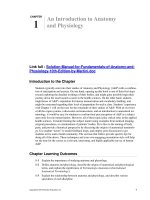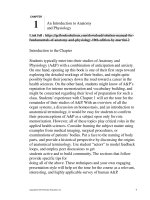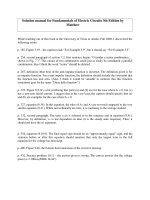Solution manual for fundamentals of digital and computer design with VHDL by sandige
Bạn đang xem bản rút gọn của tài liệu. Xem và tải ngay bản đầy đủ của tài liệu tại đây (487.53 KB, 13 trang )
Solution Manual for Fundamentals of Digital and Computer Design with VHDL by Sandige
1.16
See Figure P1.16.
Distinctive Shape
Logic Symbols
NOT or
Complement
operation
AND operation
OR operation
Figure P1.16
1.17
See Figure P1.17.
Figure P1.17
1.18
(a) F1 A B C , (b) F 2 B , (c) F 3 A B C D , (d) F 4 C
(e) F 5 S W Y , (f) F 6 P T
1.19
binary digits or bits
1.20
See Figure P1.20.
Figure P1.20
1.21
bits or identity elements
2
Full file at />
Solution Manual for Fundamentals of Digital and Computer Design with VHDL by Sandige
Full file at />1.22
See Figure P1.22.
Figure P1.22
1.23
Variable Dominant Rule, Commutative Rule, Distributive Rule, and Complement Rule.
1.24
When writing Boolean algebra expressions, the NOT operator has the highest precedence
followed by the AND operator followed by the OR operator.
1.25
A 1 A (variable dominant rule), A B B A (commutative rule),
A ( B C ) A B A C (distributive rule), and A A 0 (complement rule).
1.26
The dual of a Boolean relationship or a Boolean expression is obtained by interchanging the
identity elements (1 and 0) and the binary operators (• and +) while maintaining the order of
precedence of the operators using parentheses if required.
( X Y Z W A)D ( X (Y Z W ) A)D ( X (Y Z W ) A)
1.27 ( A B C )D A B C
( X Y Z )D (( X Y ) Z )D ( X Y ) Z
( A ( B C D ) A D )D (( A ( B (C D ))) ( A D ))D
( A ( B (C D ))) ( A D )
( A B (C D )) ( A D )
1.28
Theorems are useful equalities that are helpful in designing logic circuits.
1.29
See Figure P1.29. The theorem is the Absorption Theorem T1a: X ( X Y ) X
Figure P1.29
3
Full file at />
Solution Manual for Fundamentals of Digital and Computer Design with VHDL by Sandige
Full file at />1.30
See Figure P1.30. The theorem is the Simplification Theorem T10b: X X Y X Y
Figure P1.30
1.31
See Figure P1.31. The theorem is the Consensus Theorem T4a:
A B AC B C A B AC
Figure P1.31
1.32
See Table P1.32.
Figure P1.32
1.33
See Table P1.33.
Figure P1.33
4
Full file at />
Solution Manual for Fundamentals of Digital and Computer Design with VHDL by Sandige
Full file at />1.34
See Table P1.34.
Absorption Theorem T1a: X•(X + Y) = X
Proof by Perfect Induction Method
X Y
0 0
0 1
1 0
1 1
EOR
X+Y X•(X+Y)
0
0
1
0
1
1
1
1
=
EOL
Proof by Mathematical Manipulation Method
(proving that EOL = EOR)
X•(X + Y)
X•X + X•Y
X + X•Y
X•1 + X•Y
X•(1 + Y)
X•1
X
Note that EOL = EOR
Figure P1.34
Section 1.3 Deriving Boolean Functions from Truth Tables
1.35
(a) F1 ( X , Y ) m(3) m3 X Y (b) F2 (Y ) m(0)= m0 Y
(c) F3 ( A, B) m(1, 2,3) m1 m2 m3 A B A B A B
1.36
For minterms place an overbar just over the 0s.
1.37
See Figure P1.37.
Figure P1.37
1.38
(a) F 1 ( X , Y ) m(2) m2 X Y (b) F2 (Y ) m(1)= m1 Y
(c) F3 ( A, B) m(0,1, 2) m0 m1 m2 A B A B A B
1.39
See Figure P1.39.
Figure P1.39
5
Full file at />
Solution Manual for Fundamentals of Digital and Computer Design with VHDL by Sandige
Full file at />1.40
.
1.41
For maxterms place an overbar just over the 1s
(a) F1 ( X , Y ) M (0,1, 2) M 0 M 1 M 2 ( X Y ) ( X Y ) ( X Y )
(b) F2 (Y ) M (0) M 0 Y (c) F3 ( A, B) M (1, 2) ( A B) ( A B )
1.42
See Figure P1.42.
Figure P1.42
1.43
(a) F1 ( X , Y ) M (0,1,3) M 0 M 1 M 3 ( X Y ) ( X Y ) ( X Y )
(b) F2 (Y ) M (1) M 1 Y (c) F3 ( A, B) M (1,3) M 1 M 3 ( A B) ( A B )
1.44
See Figure P1.44.
Figure P1.44
Section 1.4 Writing VHDL Designs for Simple Gate functions
1.45
CPLD (Complex Programmable Logic Device) and FPGA (Field Programmable Gate
Array)
1.46
the entity and the architecture
1.47
The entity contains the description of the inputs and the outputs, and the architecture
contains the description of the actual circuit in terms of a Boolean function or functions.
1.48
A VHDL design consists of 3 parts. The names of the three parts are the Library Part, Entity
Declaration, and Architecture Declaration.
1.49
Keywords are reserved words that cannot be used for signal names or labels in VHDL.
1.50
The keywords are library, use, all, entity, is, port, in, out, end, architecture, of, is begin,
and, and end.
6
Full file at />
Solution Manual for Fundamentals of Digital and Computer Design with VHDL by Sandige
Full file at />1.51
There are three inputs and their names are X, Y, and Z.
1.52
See Figure P1.52.
Figure P1.52
1.53
See Figure P1.53.
Figure P1.53
1.54
See Figure P1.54.
Figure P1.54
1.55
See Figure P1.55.
Figure P1.55
1.56
See Listing P1.56.
library IEEE;
use IEEE.STD_LOGIC_1164.ALL;
entity CSOP1 is port (
a, b, c : in std_logic;
f : out std_logic
);
end CSOP1;
architecture B_function of CSOP1 is
begin
7
Full file at />
Solution Manual for Fundamentals of Digital and Computer Design with VHDL by Sandige
Full file at />f <= (not a and b and not c) or
(not a and b and c) or
(a and b and not c) or
(a and b and c);
end B_function;
Listing P56
1.57 See Waveform P1.57. Notice that F is 1 for minterms 2, 3, 6, and 7 and F is 0 for all other
minterms. This shows that the design is correct.
m0 m1 m2 m3 m4 m5 m6 m7 m0
Waveform P1.57
1.58
See Listing P1.58.
library IEEE;
use IEEE.STD_LOGIC_1164.ALL;
entity CSOP2 is port (
a, b, c : in std_logic;
f : out std_logic
);
end CSOP2;
architecture B_function of CSOP2 is
begin
f <= not ((not a and not b and c) or
(a and not b and c) or
(a and b and c));
end B_function;
Listing P58
1.59
See Waveform P1.59. Notice that F is 0 for minterms 1, 5, and 7 and F is 0 for all other
minterms. This shows that the design is correct.
m0
m1
m2
m3
Waveform P1.59
8
Full file at />
m4
m5
m6
m7
m0
Solution Manual for Fundamentals of Digital and Computer Design with VHDL by Sandige
Full file at />1.60
See Listing P1.60.
library IEEE;
use IEEE.STD_LOGIC_1164.ALL;
entity CPOS1 is port (
w, x, y, z : in std_logic;
f : out std_logic
);
end CPOS1;
architecture B_function of CPOS1 is
begin
f <= (w or x or y or z) and
(w or x or y or not z) and
(w or x or not y or z) and
(not w or not x or not y or z);
end B_function;
Listing P60
1.61
See Waveform P1.61. Notice that F is 0 for maxterms 0, 1, 2, and 14 and F is 1 for all other
maxterms. This shows that the design is correct.
M0 M1
M2 M3
M4 M5 M6 M7
m0
Waveform P1.61
1.62
See Listing P1.62.
library IEEE;
use IEEE.STD_LOGIC_1164.ALL;
entity CPOS2 is port (
x, y, z : in std_logic;
f : out std_logic
);
end CPOS2;
architecture B_function of CPOS2 is
begin
f <= not ((x or y or z) and
(x or not y or not z) and
(not x or not y or z));
end B_function;
Listing P62
9
Full file at />
M8 M9 M10 M11 M12 M13 M14 M15 M0
Solution Manual for Fundamentals of Digital and Computer Design with VHDL by Sandige
Full file at />1.63
See Waveform P1.63. Notice that F is 1 for maxterms 0, 3, and 6 and F is 0 for all other
maxterms. This shows that the design is correct.
M0
M1
M2
M3 M4 M5
M6
M7
M0
Waveform P1.63
Section 1.5 More about Logic Gates
1.64
See Figure P1.64.
Figure P1.64
1.65
See Figure P1.65.
Figure P1.65
1.66
See Figure P1.66.
Figure P1.66
1.67 See Figure P1.67.
Figure P1.67
1.68
See Figure P1.68. The names of the functionally complete gates are the NAND gate and the
NOR gate.
10
Full file at />
Solution Manual for Fundamentals of Digital and Computer Design with VHDL by Sandige
Full file at />
Figure P1.68
1.69
See Figure P1.69.
Figure P1.69
1.70
See Figure P1.70.
Figure P1.70
1.71
See Figure P1.71.
Figure P1.71
1.72
See Figure P1.72.
Figure P1.72
1.73
See Figure P1.73s.
Figure P1.73s
11
Full file at />
Solution Manual for Fundamentals of Digital and Computer Design with VHDL by Sandige
Full file at />1.74
See Figure P1.74s.
Figure P1.74s
1.75
See Figure P1.75s.
Figure P1.75s
1.76
See Figure P1.76.
Figure P1.76
1.77
See Figure P1.77.
Figure P1.77
1.78
See Figure P1.78.
Figure P1.78
1.79
See Figure P1.79.
Figure P1.79
1.80
A gate with a bubble input is an active low input. An active low input required a 0 or a low
voltage input for the input to be active or asserted.
12
Full file at />
Solution Manual for Fundamentals of Digital and Computer Design with VHDL by Sandige
Full file at />1.81
A gate with a bubble output is an active low output. An active low output provided a 0 or
low voltage output for the output to be active or asserted.
1.82
A gate that does not contain a bubble input is an active high input. An active high input
required a 1 or a high voltage input for the input to be active or asserted.
1.83
A gate that does not contain a bubble output is an active high output. An active high output
provides a 1 or high voltage output for the output to be active or asserted.
1.84
(a) 3-input NAND gate, (b) 2-input XOR gate, and (c) BUFFER
1.85
(a) 3-input NOR gate, (b) NOT gate, and (c) 2-input XNOR gate
1.86
(a) A B C , (b) A B C , and (c) A B
1.87
(a) A B , (b) A , and (c) A B C
13
Full file at />









